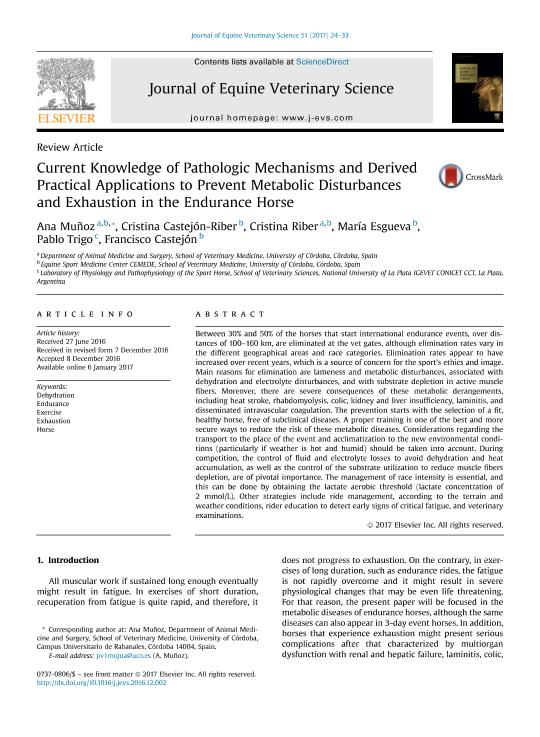Artículo
Current Knowledge of Pathologic Mechanisms and Derived Practical Applications to Prevent Metabolic Disturbances and Exhaustion in the Endurance Horse
Muñoz, Ana; Castejón Riber, Cristina; Riber, Cristina; Esgueva, María; Trigo, Pablo Ignacio ; Castejón, Francisco
; Castejón, Francisco
 ; Castejón, Francisco
; Castejón, Francisco
Fecha de publicación:
04/2017
Editorial:
Elsevier Science Inc
Revista:
Journal of Equine Veterinary Science
ISSN:
0737-0806
Idioma:
Inglés
Tipo de recurso:
Artículo publicado
Clasificación temática:
Resumen
Between 30% and 50% of the horses that start international endurance events, over distances of 100–160 km, are eliminated at the vet gates, although elimination rates vary in the different geographical areas and race categories. Elimination rates appear to have increased over recent years, which is a source of concern for the sport´s ethics and image. Main reasons for elimination are lameness and metabolic disturbances, associated with dehydration and electrolyte disturbances, and with substrate depletion in active muscle fibers. Moreover, there are severe consequences of these metabolic derangements, including heat stroke, rhabdomyolysis, colic, kidney and liver insufficiency, laminitis, and disseminated intravascular coagulation. The prevention starts with the selection of a fit, healthy horse, free of subclinical diseases. A proper training is one of the best and more secure ways to reduce the risk of these metabolic diseases. Considerations regarding the transport to the place of the event and acclimatization to the new environmental conditions (particularly if weather is hot and humid) should be taken into account. During competition, the control of fluid and electrolyte losses to avoid dehydration and heat accumulation, as well as the control of the substrate utilization to reduce muscle fibers depletion, are of pivotal importance. The management of race intensity is essential, and this can be done by obtaining the lactate aerobic threshold (lactate concentration of 2 mmol/L). Other strategies include ride management, according to the terrain and weather conditions, rider education to detect early signs of critical fatigue, and veterinary examinations.
Palabras clave:
Dehydration
,
Endurance
,
Exercise
,
Exhaustion
,
Horse
Archivos asociados
Licencia
Identificadores
Colecciones
Articulos(IGEVET)
Articulos de INST.DE GENETICA VET ING FERNANDO NOEL DULOUT
Articulos de INST.DE GENETICA VET ING FERNANDO NOEL DULOUT
Citación
Muñoz, Ana; Castejón Riber, Cristina; Riber, Cristina; Esgueva, María; Trigo, Pablo Ignacio; et al.; Current Knowledge of Pathologic Mechanisms and Derived Practical Applications to Prevent Metabolic Disturbances and Exhaustion in the Endurance Horse; Elsevier Science Inc; Journal of Equine Veterinary Science; 51; 4-2017; 24-33
Compartir
Altmétricas



